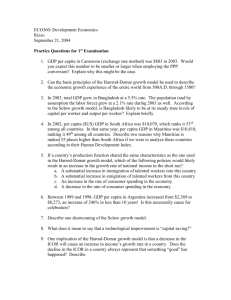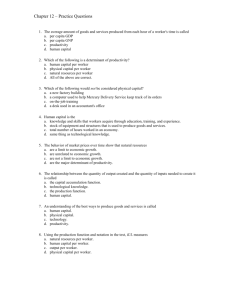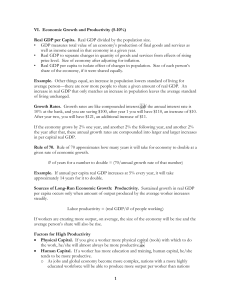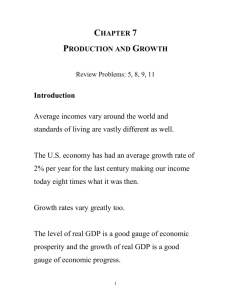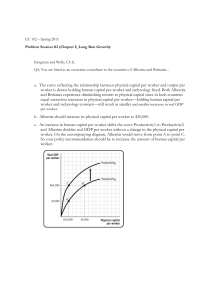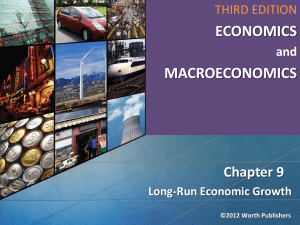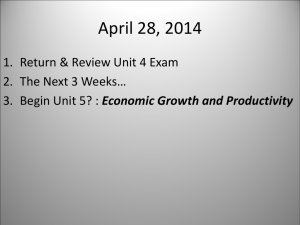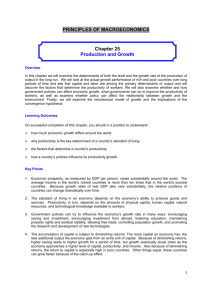Long-Run Economic Growth
advertisement
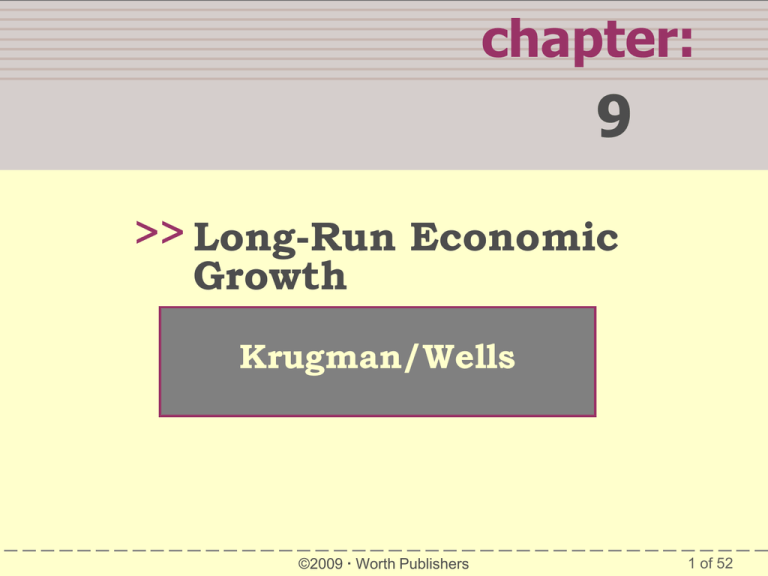
chapter: 9 >> Long-Run Economic Growth Krugman/Wells ©2009 Worth Publishers 1 of 52 Real GDP per Capita Year Percentage of 1907 real GDP per capita Percentage of 2007 real GDP per capita 1907 100% 16% 1927 129 21 1947 175 28 1967 283 46 1987 430 69 2007 620 100 2 of 52 Growth Rates How did the United States manage to produce over six times more per person in 2007 than in 1907? A little bit at a time. Long-run economic growth is normally a gradual process, in which real GDP per capita grows at most a few percent per year. From 1907 to 2007, real GDP per capita in the United States increased an average of 1.8% each year. 3 of 52 Growth Rates The Rule of 70 tells us that the time it takes a variable that grows gradually over time to double is approximately 70 divided by that variable’s annual growth rate. 4 of 52 Growth Rates Average annual growth rate of real GDP per 10% capita, 1980-2007 8.7% 8 6 4.1% 4.1% 4 2.0% 1.5% 2 0.8% 0 -1.4% -2 China India Ireland United States France Argentina Zimbabwe 5 of 52 The Sources of Long-Run Growth Labor productivity, often referred to simply as productivity, is output per worker. Physical capital consists of human-made resources such as buildings and machines. Human capital is the improvement in labor created by the education and knowledge embodied in the workforce. Technology is the technical means for the production of goods and services. 6 of 52 Accounting for Growth: The Aggregate Production Function The aggregate production function is a hypothetical function that shows how productivity (real GDP per worker) depends on the quantities of physical capital per worker and human capital per worker as well as the state of technology. 7 of 52 Diminishing Returns to Physical Capital An aggregate production function exhibits diminishing returns to physical capital when, holding the amount of human capital and the state of technology fixed, each successive increase in the amount of physical capital leads to a smaller increase in productivity. 8 of 52 Diminishing Returns to Physical Capital A Hypothetical Example: How Physical Capital per Worker Affects Productivity, Holding Human Capital and Technology Fixed Physical capital per worker Real GDP per worker $0 $0 15,000 30,000 30,000 45,000 45,000 55,000 9 of 52 Physical Capital and Productivity Real GDP per worker $60,000 1. The increase in real GDP per worker becomes 50,000 smaller . . . 30,000 C B A 0 $20,000 50,000 2. as physical capital per worker rises… 80,000 Physical capital per worker (2000 dollars) 10 of 52 What about Natural Resources? In contrast to earlier times, in the modern world, natural resources are a much less important determinant of productivity than human or physical capital for the great majority of countries. For example, some nations with very high real GDP per capita, such as Japan, have very few natural resources. Some resource-rich nations, such as Nigeria (which has sizable oil deposits), are very poor. 11 of 52 ►ECONOMICS IN ACTION The Information Technology Paradox MIT economics professor and Nobel laureate Robert Solow, a pioneer in the analysis of economic growth, declared that the information technology revolution could be seen everywhere except in the economic statistics. Paul David suggested that a new technology doesn’t yield its full potential if you use it in old ways. Productivity would take off when people really changed their way of doing business to take advantage of the new technology—such as, replacing letters and phone calls with electronic communications. Sure enough, productivity growth accelerated dramatically in the second half of the 1990… 12 of 52 The Role of Government in Promoting Economic Growth Political stability and protection of property rights are crucial ingredients in long-run economic growth. Even when governments aren’t corrupt, excessive government intervention can be a brake on economic growth. If large parts of the economy are supported by government subsidies productivity tends to suffer because of a lack of incentives. 13 of 52 Is World Growth Sustainable? Long-run economic growth is sustainable if it can continue in the face of the limited supply of natural resources and the impact of growth on the environment. Differing views about the impact of limited natural resources on long-run economic growth turn on the answers to three questions: How large are the supplies of key natural resources? How effective will technology be at finding alternatives to natural resources? Can long-run economic growth continue in the face of resource scarcity? 14 of 52 The Real Price of Oil, 1949-2007 Real domestic U.S. oil price (2000 dollars, per barrel) $60 50 40 30 20 10 1949 1960 1970 1980 1990 2000 2007 Year 15 of 52 U.S. Oil Consumption and Growth over Time Oil consumption (thousands of barrels per day) Real GDP per capita (2000 dollars) $40,000 25,000 30,000 20,000 15,000 20,000 10,000 5,000 1949 2007 10,000 1960 1970 1980 1990 2000 Year 16 of 52

